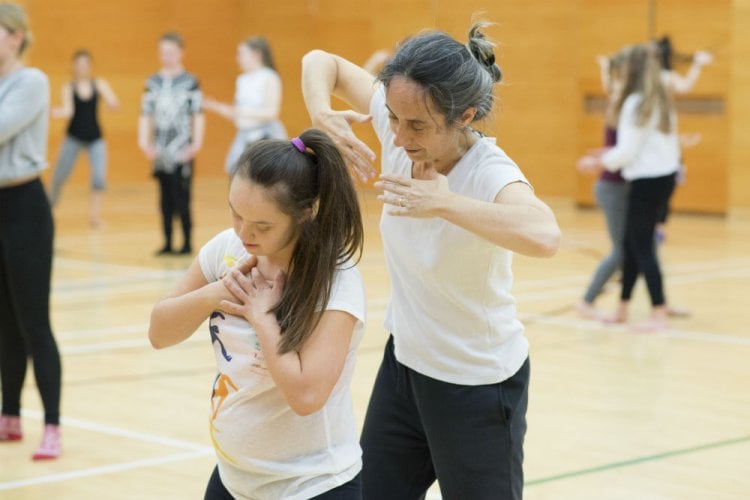
The ‘Let’s Dance’ Cooperation Project
Photo: Paul Watt and YDance
Quality European partnerships
Cultural organisations can still bid for Creative Europe funding – now and possibly after the UK has left the EU. Christoph Jankowski explains why you should consider it.
If you’re a creative or cultural organisation that works (or is looking to work) internationally, then applying for Creative Europe’s Cooperation Projects is probably something you’ve already given serious consideration to. If you haven’t, then you could be missing out on vital opportunities and funding.
The UK is the most partnered country out of nearly 40, showing how well networked its world-class creative talent is
Creative Europe is the EU support programme for the creative, cultural and audiovisual industries. With two main sub-programmes, Culture and Media, €1.46 billion is available for the period 2014 to 2020. Within the Culture sub-programme, 70% of the funding goes towards Cooperation Projects: transnational collaborative projects involving partners from creative or cultural organisations in three or more countries.
Variety and eligibility
One of the things that keeps Cooperation Projects relevant to the ever-changing needs of the UK cultural and creative sectors is the open-ended nature of what they can address. Disability arts, culture and climate change, early music, new audiences for opera, community arts, diversity, refugees and migration are some of the themes that have been explored by successful projects so far.
Whether you’re a small company or a large opera house, a specialist in one artform or a general or multidisciplinary organisation, public, private or even an educational institution, you can apply to lead or partner in a project.
Most UK beneficiaries are small or medium-sized organisations, and many use the support to help make capacity. Creative Europe isn’t for everyone though. It has to be passion and ideas-led. Going after it for the money alone would be the wrong approach.
There are eligibility requirements to make sure your project adheres to the overall programme aim of improving access to European culture and creative works and promoting innovation and creativity. To make the grade, a project needs to meet one or more of the three priority areas:
- Transnational mobility: the circulation of works, artists and professionals.
- Audience development: working with audiences, not just for them.
- Capacity building: including through digitisation, the exploration of new business models, and training and education for arts, culture and heritage professionals.
A ‘must-have’ for project eligibility is match-funding. Creative Europe will provide up to 50– 60% towards a project, capped at €200,000 for small projects and €2 million for large. The rest needs to be raised elsewhere, and every project partner is expected to make a contribution, so it’s important to make a detailed plan to account for where the rest of the money will come from.
Quality of the partnership
Another crucial ingredient is the quality of the partnership. Cooperation Projects go by this name for a reason – they are about partners working together on shared aims. You will need to form a partnership that you believe in, with partners you can trust.
There may well be times where you find the partnership to be challenging. People across different countries can work in different ways, in different languages, on different timescales and at different artistic levels. Patience and open-mindedness are important, as is meticulous planning to ensure each partner knows what is expected of them and is clear about accountability.
The stronger the partnership, the better the project will run. As this interview with a partner in Cooperation Project ‘eeemerging’ puts it: “Only apply if you really want to work together as a cooperative… If you fundamentally respect one another.”
Case study: Moving Classics
|
The project idea
The project idea needs to be a clear and strong one, well-reasoned and well-explained. You’ll need to be able to relate the central project idea or rationale and the partnership’s ambition, as well as how you’re going to make it happen or create change through the project and its activities (performances, workshops, exhibitions, research, commissions, engagement events) to match the aims of Creative Europe.
Post-Brexit business
So why are we encouraging organisations to apply to Creative Europe when the UK is supposed to be leaving the EU? It’s absolutely business as usual until the UK leaves, and we’re expecting this to be the case at least until the end of 2018. There’s no bias against UK applicants, plus the UK Treasury will cover payments for UK-led or partnered projects that continue beyond the UK’s exit from the EU, if they are selected for support before the leave date.
Crucially, the UK could well continue to be part of Creative Europe – the Prime Minister has said that the UK would consider paying in to some smaller EU programmes. There are currently 11 non-EU countries that participate in Creative Europe, so it’s up to the UK Government’s position on this, and the upcoming negotiations to determine whether the UK can and will be one of them.
It’s worth bearing in mind that the UK is one of the most highly benefiting countries, both in terms of cash, but more importantly in terms of the networks, partnerships, new audiences and new ideas that the programme facilitates. The UK is the most partnered country out of nearly 40, showing how well networked its world-class creative talent is.
Find your partners
The next deadline for Cooperation Projects later this year may seem like a while away, but it takes time to build trust and understanding and a shared vision. So if you’re thinking of applying, now is the time to get your partners together, think about how you can collectively put forward a high-quality project that meets the programme priorities, and work out the details of the project plan and budget.
Christoph Jankowski is Head of Culture, England and Culture Advisor at Creative Europe Desk UK.
www.creativeeuropeuk.eu
Tw: @CEDUK_Culture
Join the Discussion
You must be logged in to post a comment.